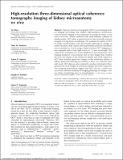High-resolution three-dimensional optical coherence tomography imaging of kidney microanatomy ex vivo
Author(s)
Chen, Yu; Andrews, Peter M.; Aguirre, Aaron Dominic; Schmitt, Joseph M.; Fujimoto, James G.
DownloadChen-2007-High-resolution thre.pdf (2.683Mb)
PUBLISHER_POLICY
Publisher Policy
Article is made available in accordance with the publisher's policy and may be subject to US copyright law. Please refer to the publisher's site for terms of use.
Terms of use
Metadata
Show full item recordAbstract
Optical coherence tomography (OCT) is an emerging medical imaging technology that enables high-resolution, noninvasive, cross-sectional imaging of microstructure in biological tissues in situ and in real time. When combined with small-diameter catheters or needle probes, OCT offers a practical tool for the minimally invasive imaging of living tissue morphology. We evaluate the ability of OCT to image normal kidneys and discriminate pathological changes in kidney structure. Both control and experimental preserved rat kidneys were examined ex vivo by using a high-resolution OCT imaging system equipped with a laser light source at 1.3-μm wavelength. This system has a resolution of 3.3 μm (depth) by 6 μm (transverse). OCT imaging produced cross-sectional and en face images that revealed the sizes and shapes of the uriniferous tubules and renal corpuscles. OCT data revealed significant changes in the uriniferous tubules of kidneys preserved following an ischemic or toxic (i.e., mercuric chloride) insult. OCT data was also rendered to produce informative three-dimensional (3-D) images of uriniferous tubules and renal corpuscles. The foregoing observations suggest that OCT can be a useful non-excisional, real-time modality for imaging pathological changes in donor kidney morphology prior to transplantation.
Date issued
2007-05Department
Massachusetts Institute of Technology. Department of Electrical Engineering and Computer Science; Massachusetts Institute of Technology. Research Laboratory of ElectronicsJournal
Journal of Biomedical Optics
Publisher
SPIE
Citation
Chen, Yu, Peter M. Andrews, Aaron D. Aguirre, Joseph M. Schmitt, and James G. Fujimoto. “High-Resolution Three-Dimensional Optical Coherence Tomography Imaging of Kidney Microanatomy Ex Vivo.” Journal of Biomedical Optics 12, no. 3 (2007): 034008. © 2007 SPIE
Version: Final published version
ISSN
10833668
1560-2281